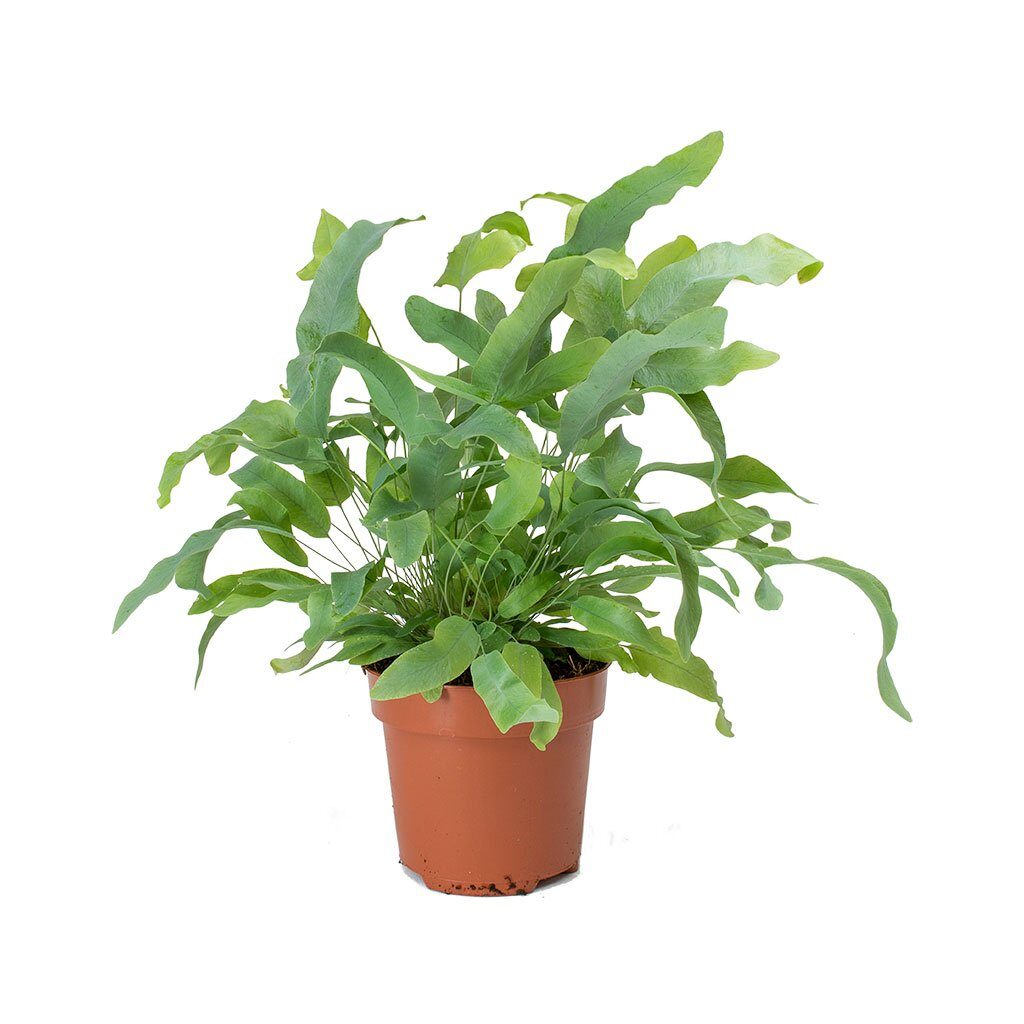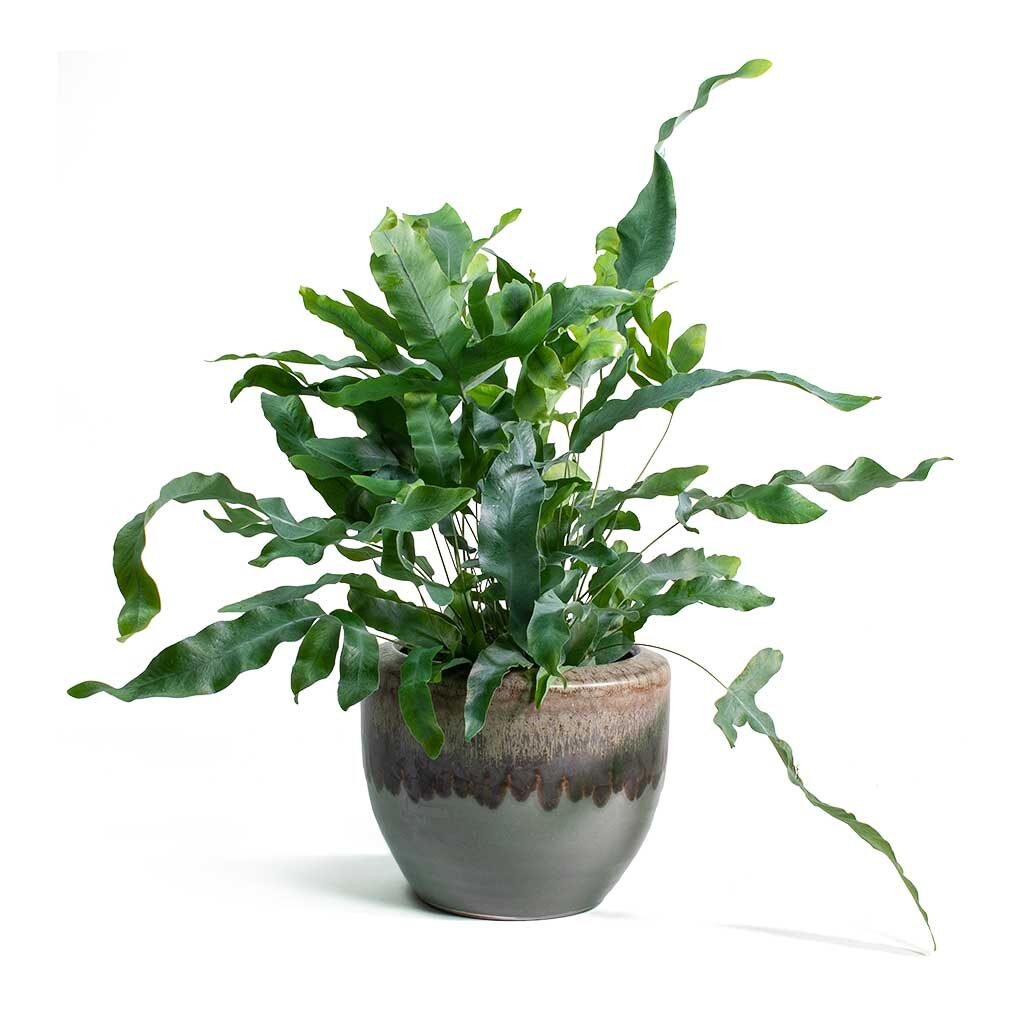The blue star fern also called phlebodium aureum is an exciting fern with elongated fronds and vibrant green-blue color. The houseplant is a perfect choice for season growers and beginners due to the ease of care.
Blue star fern care involves the provision of high humidity, bright indirect sunlight, well-draining potting soil, and slightly moist soil. Maintain an indoor temperature of 57-81oF (14-27oC) and feed the fern every 2-3 months during spring and summer.
Continue reading this blue star fern care guide to experience successful growth. The guide also highlights the blue star fern problems and their respective solutions. Let’s get started with the basics.
You May Also Like: How to Care for Areca Palm

What Does Blue Star Fern Look Like?
The blue star fern is an epiphytic fern that belongs to a member of the oak family. The fern has bluish-green foliages that do not shed upon getting old.
The fern usually branches into fingers to retain its attractiveness and symbolize the star shape. It has air-purifying powerhouse traits that keep rooms calm and freshen up.
Besides that, the coloration contrast well with other houseplants and many interior decors for offices or living areas. The fern tends to stand out both in pots and hanging baskets.
The fronds can reach one to two feet long or more. Small and juvenile blue star ferns are excellent for terrariums. Outdoor blue star fern can grow up to three feet tall.
Phlebodium aureum is a slow-growing fern species that experience active growth during spring and summer. The fern species can thrive both indoor and outdoor in a warm climate.
The blue star fern is commonly known as palm boot fern, golden polypody, golden foot fern, golden serpent fern; bear’s paw fern, and cabbage palm fern.
The good news is that blue star fern is non-toxic to humans and pets. I recommend keeping the fern away from pets and toddlers to avoid destruction.
Blue Star Fern Care Details
| Origin | Central and South America |
| Scientific Name | Phlebodium aureum |
| Common Names | Blue star fern Golden polypody Cabbage palm fern |
| Maximum Growth (Approx.) | 0.6 to 1m |
| Light Requirements | Bright indirect sunlight. It can also cope with low light conditions and not direct sunlight. |
| Watering Frequency | Maintain consistent moist soil. Water the fern when 2-3 inch topsoil is dry. |
| Potting Soil Requirements | Well-draining potting mix with the ability to hold moisture without getting soggy. |
| Best Temperature Range | 57-81oF (14-27oC). Cannot tolerate cold drafts. |
| Fertilizer Application | Minimal fertilizer requirement. Feed the fern 2-3 months during spring and summer with a balanced fertilizer. |
| Humidity Requirements | Average to high humidity. The fern can tolerate low humidity for some days. |
| Flowering | Does not bloom. Produce a row of bright orange spores’ underside the fronds. |
| Pruning | To remove dead leaves and maintain size. |
| Propagation | By rhizome division or spores |
| Re-potting | Sensitive to re-potting. Transplant in case of root-bound issues. |
| Pests and Diseases | Pests: Less susceptible to pest infestation Diseases: Root rot due to overwatering |
| Toxicity | Non-toxic to humans and pets |
Sources: New York Botanical Garden
How to Care for Blue Star Fern
Blue Star Fern Soil Mixture
The cabbage palm fern does best in well-draining soil with a pH range of 5.6 to 6.0. The potting mix should stay moist without getting soggy.
Blue star fern is an epiphyte that grows on the surface of other plants for survival. The growing habits make the fern not thrive well in standard potting soil.
An orchid mix is the best substrate for this epiphyte. Another option is to combine equal parts of standard potting mix with perlite and peat moss.
Blue Star Fern Light Requirement
The golden polypody can ensure low-light conditions without becoming fussy. But this fern species prefers bright indirect sunlight to thrive well.
Protect the blue star fern from direct sunlight due to the scorching effect. It is the only indoor fern species that can tolerate high sunlight intensity for hours.
Relocate your blue star fern to about three feet from the north-facing window due to the presence of bright indirect sunlight. The curtains and shears act as protective gear from direct sunlight.
Blue Star Fern Watering Needs
The blue star fern is a tropical plant that flourishes in moist soil. Every houseplant enthusiast should replicate such growing conditions at home.
Water the fern weekly during spring and summer. Remember to reduce the watering frequency in winter due to the dormancy phase effect.
The golden rule is to inspect the potting soil moisture content before watering. Insert the index finger in about 2-3 inches of topsoil; soak the soil if it is dry.
Use distilled water or rainwater direct on the potting soil without wetting the leaves. Too much water increases the risk of root rot.
Blue Star Fern Humidity Level
Most tropical plants thrive in a warm and humid environment. Blue star ferns love indoor humidity of about 75% to stay happy and healthy.
The bathroom is the best place for growing blue star fern due to high humidity and natural light. Use a humidifier to boost the humidity level in the rest of the house.
Low humidity makes the foliages develop brown tips and edges. High humidity with poor ventilation and light increases the risk of pest infestations.
Temperature Range for Blue Star Fern
The blue star fern is a warm-weather plant that cannot survive in frost. Besides that, cold temperatures trigger dormancy and stunted growth.
The cabbage palm fern usually shed leaves in winter until warm temperature return. Do not freak if this decorative plant encounters such scenarios.
The ideal indoor temperature range for blue star fern is 57-81oF (14-27oC). The fern species can be grown outdoors under USDA zones nine and above.
Blue Star Fern Fertilizer Application
A blue star fern is a light feeder. There is a high chance of overfeeding than underfeeding when grown at home. Use mild and well-diluted fertilizer to feed your blue star fern.
I recommend water-soluble fertilizer rich in nitrogen. Apply the fertilizer every month during spring and summer. Do not fertilize a sick cabbage palm fern due to shock stress.
Another excellent option with a low risk of over-fertilization is organic fertilizer or compost. It would be best to read my guide on How to Make Homemade Fertilizer for Houseplants.
Blue Star Fern Flowers
Blue star fern is a non-flowering tropical fern. It is grown due to the blue-green foliages that support the backdrop to a flowering scene.
The fern can produce two rows of bright-orange spore-producing dots underside of its fronds. It is ideal for a science project and not a festive display.
Pruning and Maintenance
Pruning is an essential blue star fern care regime. It helps to remove leggy stems and dead foliages to redirect energy to growing parts.
Trimming helps to maintain certain shapes and sizes. Besides that, it helps to prevent pest infestations and diseases. It is not ideal for promoting specific growth.
Use sharp and sterilized pruner when removing errant stems and dead foliages. Undertake the task during springtime.
Blue Star Fern Propagation
Blue star fern can be propagated through rhizome division and spores. Growing new plants from spores is a slow process when compared to rhizome division.
Cut a rhizome with multiple leaves and roots. Plant the section in a pot with an orchid mix or other well-draining potting soil. Water the rhizome for two to three days. It will take a month to grow.
Another option is to sprinkle mature spores on the potting mix. Wrap with clear plastic and keep the soil moist. Germination will take two or five months.
How to Repot Blue Star Fern
Blue star fern is sensitive to re-potting. Any slight root disruption might ruin the plant’s health and well-being. I recommend re-potting the fern after two years in case of a pot-bound issue.
Remove the fern from the pot with ultimate care. Transplant the blue star fern in a container about one to two-inch larger than the current pot.
Do not bury the rhizome in the soil. Water the plant and provide other essential care. It will take a couple of weeks to acclimate to the new potting soil.
Common Problems and Solutions
Pests
Blue star fern is less vulnerable to insect infestations. But it does not imply that the houseplant is invincible to pests. The sap-sucking insects occur due to poor ventilation and a moist environment.
Aphids, spider mites, thrips, scales, and mealybugs are the most common pests attacking this houseplant. Use insecticidal soap to get rid of them.
Diseases
Most blue star fern diseases occur due to excess moisture. Overwatering causes root rot, southern blight, and mildew.
Avoid misting the leaves to prevent fungal growth and use a well-draining potting mix to avoid overwatering issues. Prevention is better than treatment.
You May Also Read: How to Care for Oyster Plant
Frequently Asked Questions
Are Blue Star Ferns Edible?
No. Most ferns are not edible and they contain thiaminase enzymes that steal vitamin B complex from the body. Grow blue star fern in a pot and keep away from children or pet reach.
Is Blue Star Fern Toxic to Humans and Pets?
No. Blue-star fern is safe for cats and dogs to nibble. But the fern leaves and stems are not delicious to entice your furry friends.
Why Does My Blue Star Fern Have Dry Leaves?
Dry leaves are a sign of under-watering and low humidity. The blue star fern crispy leaves are extreme signs of dehydration. Soak the potting soil to revive the cabbage palm fern.
Why Are My Blue Star Fern Leaves Turning Brown?
Low humidity, over-fertilization, and water quality are the possible cause of blue star fern leave turning brown. Use a humidifier to boost humidity levels and flush the potting soil.
Remember to use rainwater or distilled water instead of tap water. Reduce the feeding frequency to combat soil toxicity.

Conclusion
The blue star fern is the only forgiving fern species to grow indoors. It can cope with indoor growing conditions without becoming fussy.
Blue star fern displays brown and dry fronds is a sign of under-watering, excessive sunlight exposure, and dry air condition.
How to care for phlebodium aureum involves the provision of bright indirect sunlight, high humidity, moderate soil moisture, and well-draining potting mix.
I hope this comprehensive care sheet will help you grow and care for blue star fern-like an expert. Take the time to read through and bring a tropical feeling to your living space.
